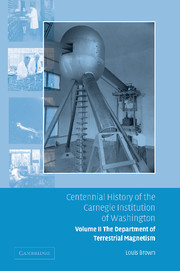Book contents
- Frontmatter
- Contents
- Foreword by Richard A. Meserve
- Preface
- 1 Establishment
- 2 Cruises and war
- 3 Expeditions
- 4 Measurements: magnetic and electric
- 5 The Fleming transition
- 6 The last cruise
- 7 The magnetic observatories and final land observations
- 8 The ionosphere
- 9 Collaboration and evaluation
- 10 The Tesla coil
- 11 The Van de Graaff accelerator
- 12 The nuclear force
- 13 Fission
- 14 Cosmic rays
- 15 The proximity fuze and the war effort
- 16 The Tuve transition
- 17 Postwar nuclear physics
- 18 The cyclotron
- 19 Biophysics
- 20 Explosion seismology
- 21 Isotope geology
- 22 Radio astronomy
- 23 Image tubes
- 24 Computers
- 25 Earthquake seismology
- 26 Strainmeters
- 27 The Bolton and Wetherill years
- 28 Astronomy
- 29 The solar system
- 30 Geochemistry
- 31 Island-arc volcanoes
- 32 Seismology revisited
- 33 Geochemistry and cosmochemistry
- 34 The Solomon transition
- 35 The support staff
- 36 Epilogue
- Notes
- Index
32 - Seismology revisited
Published online by Cambridge University Press: 06 January 2010
- Frontmatter
- Contents
- Foreword by Richard A. Meserve
- Preface
- 1 Establishment
- 2 Cruises and war
- 3 Expeditions
- 4 Measurements: magnetic and electric
- 5 The Fleming transition
- 6 The last cruise
- 7 The magnetic observatories and final land observations
- 8 The ionosphere
- 9 Collaboration and evaluation
- 10 The Tesla coil
- 11 The Van de Graaff accelerator
- 12 The nuclear force
- 13 Fission
- 14 Cosmic rays
- 15 The proximity fuze and the war effort
- 16 The Tuve transition
- 17 Postwar nuclear physics
- 18 The cyclotron
- 19 Biophysics
- 20 Explosion seismology
- 21 Isotope geology
- 22 Radio astronomy
- 23 Image tubes
- 24 Computers
- 25 Earthquake seismology
- 26 Strainmeters
- 27 The Bolton and Wetherill years
- 28 Astronomy
- 29 The solar system
- 30 Geochemistry
- 31 Island-arc volcanoes
- 32 Seismology revisited
- 33 Geochemistry and cosmochemistry
- 34 The Solomon transition
- 35 The support staff
- 36 Epilogue
- Notes
- Index
Summary
When seismology was first studied at DTM the only data from the explosion-induced waves were the times of first arrivals and their amplitudes. This information sufficed to resolve questions about the structure of the crust and to locate earthquake sources as well as to examine some questions about interior structure. It was well understood, of course, that the seismometer signals following the first arrival contained valuable information, but the seismograms were compounds of the poor frequency response of the receiving instruments and the complexity of arriving signals. During the last quarter of the century a continual improvement of seismometers and the remarkable expansion of computer power allowed investigators to dispose of most of these restrictions. A memorable step was the acquisition in 1982 of the Digital Equipment Corporation VAX 11/780 computer that was located at the Geophysical Laboratory and connected to the local PDP11/34 by a high-speed telephone link.
The earthquake generation of seismic waves results from the motion of the rock surfaces on faulting. Important parameters are the total energy release, the area of slipping, the amount and direction of displacement and its duration. The seismogram is the record of the motion of the rock as received at the instrument location, but this record is a composite of the response of the instrument, which is known, and the attenuation and propagation for the region between source and receiver, quantities that are generally known within limits that allow meaningful adjustment.
- Type
- Chapter
- Information
- Centennial History of the Carnegie Institution of Washington , pp. 239 - 244Publisher: Cambridge University PressPrint publication year: 2005



